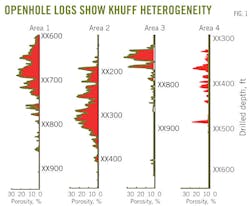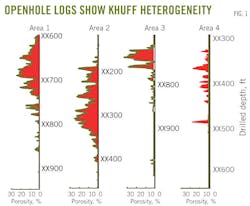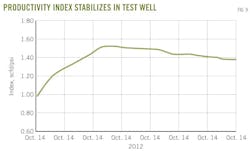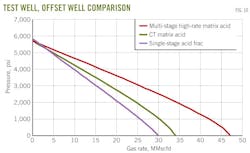Limited-entry OHMS improves Saudi deep-gas production
Mahbub S. Ahmed
Zillur Rahim
Hamoud A. Al-Anazi
Adnan A. Al-Kanaan
Saudi Aramco
Wael El-Mofty
Packers Plus Energy Services Inc.
Dubai
| Based on a paper presented to the SPE Annual Technical Symposium and Exposition, al- Khobar, Saudi Arabia, May 19-22, 2013. |
The Permian Khuff carbonate reservoir in the Ghawar structure of Saudi Arabia produces nonassociated gas and condensate. Saudi Aramco has been successfully exploiting its deep Khuff gas reservoirs for the past decade drilling vertical and horizontal wells and hydraulically fracturing them in single and multiple stages (OGJ, Oct. 4, 2010, p. 66; June 6, 2011, p. 66).1-3
All Khuff gas producers require acid stimulation, either matrix acid or acid fracturing, before connecting to the gas plant. Matrix acid removes near-wellbore damage incurred during drilling, while acid fracturing opens channels beyond the near-wellbore region. Both improve well productivity, but in relatively tighter reservoirs, acid fracturing provides the best opportunity for well productivity enhancement.
Some Khuff wells may need only a simple matrix acid treatment, while other wells may need openhole multistage (OHMS) fracture stimulation. Results demonstrate that OHMS completion was required to stimulate successfully all net pay intervals resulting in high productivity.
This article presents an overview of Saudi Aramco's evaluation of various stimulation methods used in the Khuff reservoir and highlights an optimal carbonate stimulation technique for certain reservoir conditions via the successful application of a limited-entry OHMS completion for effective stimulation.
Khuff reservoir characteristics
The Khuff formation represents the earliest major transgressive carbonate deposited on a shallow continental shelf in eastern Saudi Arabia. The reservoir properties can vary greatly due to the huge surface area the reservoir covers. Rock diagenesis, dolomitization, leaching, and other chemical changes affect reservoir properties and fluid flow characteristics.4
The reservoir is a high-pressure, high-temperature carbonate with two main gas-bearing layers: a tight dolomite, Khuff-B; and a more prolific calcite, Khuff-C. The reservoir exhibits extensive heterogeneity in stress, flow capacity, and fluid properties throughout the field (Fig. 1).
This heterogeneity, combined with the deep and hot nature of the reservoir, has made it a difficult to achieve uniform and effective stimulation of all layers.5 Consequently, well-production potential can fluctuate widely if treatments are not optimized.
Over the past decade, several wells have penetrated the Khuff reservoir both vertically and horizontally, providing valuable information on its characteristics. Stimulation of these wells is often needed for successful development and maintaining potential of the nonassociated Khuff gas in Saudi Arabia.
Vertical stimulation
In early development, Khuff producers were drilled vertically and stimulated. The vertical wells were cased with either a 7-in. or 4½-in. liner and cemented. The wells were matrix acid stimulated with an injection pressure below fracture initiation pressure. This type of stimulation is used mainly for wells possessing good reservoir quality.
Wells drilled in tighter reservoir sections require acid fracturing to increase productivity. Typically, a single acid fracture across the perforated zones is sufficient.
The perforation intervals are chosen based on the rock porosity and stresses, which are calculated from the openhole logs calibrated by core and diagnostic fracture injectivity test (DFIT) data.2 The job's final design is calibrated with prefracture injection parameters and subsequent analysis. Generally, a successful stimulation treatment will generate a fracture half-length of 100-150 ft and a fracture conductivity of 2,000-3,000 millidarcy-feet.
Horizontal stimulation
Later, most Khuff development wells were drilled horizontally. Stimulation of horizontal producers depends on how the well is completed.
If the horizontal well is completed open hole and reservoir development can be categorized between moderate and good quality, the well is simply stimulated by bullheading acid into the wellbore.
In this process, there is little control over the intervals at which the acid will penetrate. It is very likely that the high-permeability intervals will be stimulated, leaving the low-permeability intervals. Therefore, this type of acid stimulation may not be the best option. In barefoot completions, in which wellbore accessibility and stability can be difficult, bullheading acid to stimulate the well may be the only option.
Horizontal wells completed open hole can also be stimulated with acid deployed by coiled tubing (CT). This process uses CT to inject acid into various portions of the wellbore, which means different intervals can be stimulated independently and selectively. This type of stimulation falls under matrix stimulation rather than acid fracturing.
OHMS completion
In 2001, OHMS completions were commercialized in North America. OHMS enabled the segmenting of long laterals for selective-multistage-fracturing (MSF) treatment of individual segments and subsequent isolation for zone shutoff if required. Saudi Aramco began using OHMS completion technology in 2007.
In Aramco's application, the rig deploys MSF equipment during completion of the well. Subsequently, acid fracturing is conducted in multiple stages through the fracturing ports, which are activated by the ball-dropping mechanism (Fig. 2).
If the well is drilled in the maximum stress direction (σmax), the first-stage fracture will grow longitudinally parallel to the wellbore toward σmax, causing the potential risk of overlapping with subsequent fractures. Initiation of the second and third fractures can become difficult due to possible pressure communication with the first induced fracture.8 The MSF may be changed to a single-stage fracture followed by additional stages of matrix stimulation.
Avoiding fracture overlapping requires wells to be drilled in the minimum stress direction (σmin), allowing the fractures to initiate perpendicularly to the wellbore. Drilling these wells toward σmin, however, often presents such problems as wellbore instability and differential sticking.
Adequate hole preparation and drag modeling are needed to mitigate potential mechanical sticking, while the 1D Mechanical Earth Model and its continuous calibration via real-time geomechanics are needed to fine tune drilling parameters to avoid breakouts or stuck pipe.7 Although drilling toward σmin is difficult, the improved long-term, sustained productivity and effective MSF treatment it enables justify this strategy.
More recently, a trial test was successful in the field implementing a novel stimulation technique that provides limited-entry, selective, multistage matrix acid stimulation.
Limited-entry OHMS
Limited-entry OHMS stimulation and matrix acidizing systems function similarly to standard OHMS completion systems. Multiple stages are created with hydraulically set mechanical packers for isolation enabling independent fracture stimulation by straddling off of individual sections of a wellbore, depending on reservoir characteristics and production targets.
Limited-entry systems differ in that, instead of one fracture port per stage, multiple limited-entry, shear-activated stimulation jets are installed to provide controlled injection and leak off. This effectively places the desired treatment at a constant rate and pressure along the stage length, thereby maximizing the development of complex wormholes and conductive channels along the stimulated reservoir length.
Stimulating each successive stage individually in the horizontal leg requires both the liner and the annulus be isolated. Liner isolation is achieved by the actuation balls as they land on their respective seats to isolate the stages below.
Isolation of the annulus occurs with hydraulically set mechanical, dual-element packers designed to withstand high differential pressures during treatment cycles at reservoir temperatures. Design of these packers features a dynamic setting mechanism that continuously delivers additional packoff forces to the elements as the treatment pressures increase over the initial setting pressure inside the liner. This criterion allows the packer to cope with the sudden downhole temperature drop as colder treatment fluids are pumped from the surface.
Each stage consists of a drillable cutter assembly pinned into a shear housing assembly. Below the shear housing are the shear-activated stimulation jet assemblies, spaced with the casing and liner at predetermined depths (Fig. 3). Above the lowest packer in each stage is the locking, landing sub. Multiple stages can be run with the largest ball size being at the top.
Preparing for OHMS application
Stage engineering and segmentation take place after review and evaluation of the openhole logs recorded during drilling or post-drilling on wireline. At minimum, density neutron, porosity, and resistivity data are required to determine formation fluids, permeability, and other reservoir properties. Borehole caliper logs are essential to determine wellbore geometry and to pick the best locations for setting the openhole packers.
At the end of the logging program but before the limited-entry, multi-jet system deployment, a special reaming trip uses a proprietary dual solid-blade spiral reamer, designed to mimic the dimensions and stiffness of the completion string. This mitigates the risk of mechanical sticking and ensures successful installation.8 9
OHMS installation, stimulation
Once the deployment schematic is generated showing target-setting depths for each system component and the allowable tolerance, a completion tally is designed with proper spacing, and the system is deployed to target depth. During deployment, the system is open-ended to allow circulation through the liner to the bottom according to normal procedures.
After the completion assembly is run to the target-setting depth, a small ball is dropped from the surface and circulated to the lowest end of the completion assembly, where it lands in the seat of a toe-circulation sub and closes off the system.
Increased surface pressure sets the liner hanger; further increased pressure sets all of the openhole packers at once, thereby segmenting the openhole lateral into predetermined stages for selective stimulation. The running tool is released and pulled out of the hole, leaving the multistage, lower completion set with a polished bore receptacle to connect with the upper completion, which is run on a lower seal assembly to sting into the liner hanger. The well is secured and the drilling rig released.
Fracture stimulation starts by application of surface pressure to open the lowest hydraulically activated fracture port (Stage-1) and establishment of direct injectivity into the reservoir rock (Fig. 4). The DFIT and the main treatment are then performed according to the Stage-1 program.
At the top of each successive stage above Stage-1 is a shear housing, drillable cutter assembly that is opened when an actuation ball lands on its ball seat. Once the actuation ball lands on the appropriately sized seat, pressure increases in the liner.
When the activation differential pressure is reached within the liner, the drillable cutter assembly shears off and moves down the length of the stage to open each jet by cutting off its metal pin. The drillable cutter assembly then lands in a locking, landing sub at the bottom of the stage, providing isolation from the lower stages.
Increasing ball and seat sizes enables multiple stages to be run in sequence. Smaller incremental sizing of the balls and seats allows for more stages without sacrificing the minimum acceptable restriction inside the completion.
The balls are typically flowed back to the surface or rattle in place for a short period until they mechanically or chemically disintegrate, depending on their composition. If necessary, the drillable cutter assembly can be milled out to achieve a full liner inside diameter; the landing-locking sub also features a locking profile to prevent the drillable cutter from rotating during milling operations.
Khuff OHMS test stimulation
The limited-entry system described here is best suited for matrix-acid treatments in prolific and naturally fractured carbonate formations. Matrix-acid stimulation reduces the formation damage (skin factor) caused during drilling and enhances near wellbore conductivity for improved production.
Carbonates readily dissolve in acid. Therefore, pumping acid below fracture pressure into the wellbore creates highly conductive flow paths known as wormholes that transport reservoir fluids from within the formation matrix directly into the wellbore, overcoming both low permeability and near wellbore skin (Fig. 5).
In addition, these multistage, limited-entry, multi-jet systems can be used in various configurations, depending on the desired completion strategy and lateral-section-management requirements. A full, limited-entry, multi-jet system or a combination of this with a standard OHMS system configuration can suit individual requirements (Figs. 6 and 7).
The Khuff wells' completion and stimulation history shows that, based on the reservoir quality, almost every standard stimulation technique has been tried. This includes single, bullhead-acid treatment and CT-acid wash in prolific reservoirs, cased-hole-plug-and-perforation techniques through cemented liners, and OHMS-fracture treatments in low-to-moderate permeability intervals.
Relatively tighter formations require OHMS fracturing treatments to achieve an extended fracture half-length. In relatively prolific reservoirs, where MSF treatments may not be necessary, the choice is between CT acid treatments and multistage matrix acid. The multistage limited-entry technique has shown considerable success.
Accurate acid placement is a major concern in matrix acidizing of prolific carbonates because the acid tends to flow preferentially where the permeability is highest, further increasing local permeability at these intervals and leaving the lower permeability regions of the reservoir untreated. Industry experience shows that a large percentage of matrix treatments around the globe do not meet expectations because of improper design. In some cases, huge increases in water production occur after a stimulation job because the acid may have preferentially stimulated the high-permeability sections associated with water.
Due to the rapid reaction of carbonates with acid, matrix acidizing creates dominant wormholes through which the acid flows with ease, leaving most of the pay zone unstimulated. This cannot be avoided if the acid is simply bullheaded into the well and allowed to find its own natural route.
Some form of combined mechanical and chemical diversion is necessary for effective placement of the stimulation fluids to attain optimum depth and complexity of wormholes, which will facilitate hydrocarbon flow from the formation matrix to the wellbore.
Outperforms matrix acid
In the Khuff reservoir, a relatively prolific horizontal well (Well-A) was drilled geometrically parallel to the maximum-principle stress plane, σmax. The well was logged and composite logs were carefully analyzed for reservoir porosity development. The three-stage OHMS limited-entry, multiple injection port system, with six limited-entry injection ports per stage, was successfully deployed to total depth in this 4,000-ft horizontal section (Fig. 8).
Matrix pumping was performed according to the approved treatment program. All system components functioned as initially expected. The DFIT was performed for each stage and the main matrix acid treatments were pumped according to the program.
Well-A was opened for cleanup and flow back. The recorded gas rate confirmed stable production at a high productivity index (PI; Fig. 9). Well PI was compared with the two offset wells: one vertical well, which was acid fractured in a single stage and one horizontal well, which was matrix acid stimulated with CT. The well performance was matched, and a wellbore skin calculated.
In this comparison, the limited-entry, high-rate, multistage matrix with a calculated skin of -3.4 outperformed the CT matrix acid well with a calculated skin of -2.0. The vertical well with a single stage acid fracture had the lowest PI with a calculated skin of -5.7 (Fig. 10).
Saudi Aramco drew the following conclusions from the limited-entry OHMS work performed in the Khuff reservoirs.
• Optimization of acid stimulation depends on reservoir quality and well configuration.
• A novel approach to address the more prolific Khuff intervals, where efficient matrix acidizing was sufficient to meet expected well rates, was successfully implemented. The limited-entry OHMS completion has shown promise in its first application, although more testing is required.
• This stimulation technology is readily applicable to those wells that have good reservoir development but require near-wellbore stimulation on large intervals.
• This technique is not a replacement for traditional MSF in moderate to tight gas reservoirs that require deep penetration. Acid fracturing through this current system may be evaluated in the future.
Acknowledgements
The authors would like to thank the management of Saudi Aramco for their permission to publish this article. Special thanks go to the Packers Plus and Schlumberger teams for providing close cooperation and assistance during the initial modeling, implementation, and presentation phases of the limited-entry, multi-jet OHMS completion technology.
References
1. 2009-2012 Gas Program, Saudi Aramco Gas Reservoir Management Division Internal Documentation, 2013.
2. Al-Qahtani, M.Y., and Rahim, Z., "A Mathematical Algorithm for Modeling Geomechanical Rock Properties of the Khuff and pre-Khuff Reservoirs in Ghawar Field," SPE Middle East Oil Show, Bahrain, Mar. 17-20, 2001.
3. Rahim, Z., Al-Qahtani, M.Y., and Buhidma, I., "Improved Gas Recovery from Acid of Hydraulic Fracturing," Saudi Aramco Journal of Technology, Spring 2001, pp. 50-60.
4. Plumb, R.A., "Influence of Composition and Texture on Failure Properties of Clastic Rocks," Rock Mechanics in Petroleum Engineering, Delft, the Netherlands, Aug. 29-31, 1994.
5. Rahim, Z., Al-Anazi, H.A., Al-Kanaan, A.A., Makmun, A., Fredd, C., and Gurmen, N., "Evolving Khuff Formation Gas Well Completions in Saudi Arabia: Technology as a Function of Reservoir Characteristics Improves Production," SPE Middle East Unconventional Gas Conference and Exhibition, Muscat, Jan. 28-30, 2013.
6. Plumb, R.A., Edwards, S., Pidcock, G., Lee, D., and Stacey B., "The Mechanical Earth Model Concept and Its Application to High Risk Well Construction Projects," IADC/SPE Drilling Conference, New Orleans, Feb. 23-25, 2000.
7. Ahmed, M., Rahim, Z., Al-Anazi, H.A., Al-Kanaan, A.A., and Mohiuddin, M., "Development of Low Permeability Reservoir Utilizing Multistage Fracture Completion in the Minimum Stress Direction," SPE Saudi Arabia Section Technical Symposium and Exhibition, al-Khobar, Apr. 8-11, 2012.
8. Al-Ghazal, M.A., Al-Driweesh, S.M., and El-Mofty, W., "Practical Aspects of Multistage Fracturing from Geosciences and Drilling to Production: Challenges, Solutions and Performance," Middle East Oil and Gas Show and Conference, Manama, Bahrain, Mar. 10-13, 2013.
9. Al-Jubran, H.H., Wilson, S., and Johnston, B., "Successful Deployment of Multistage Fracturing Systems in Multilayered Tight Gas Carbonate Formations in Saudi Arabia," SPE Deep Gas Conference and Exhibition, Manama, Bahrain, Jan. 24-26, 2010.
The authors
Mahbub S. Ahmed ([email protected]) is a petroleum engineering consultant with Saudi Aramco's gas reservoir management department. He holds a bachelor of science in petroleum engineering from the Institut Algérien du Pétrole, Boumerdes, Algeria, and a masters of science in petroleum engineering from the University of Oklahoma. He is a member of the Society of Petroleum Engineers.
Zillur Rahim (rahim.zillur@aramco) is a senior petroleum engineering consultant with Saudi Aramco's gas reservoir management department. He holds a bachelor of science from the Institut Algérien du Pétrole, Boumerdes, Algeria, and a masters of science and PhD from Texas A&M University, College Station, all in petroleum engineering.
Hamoud A. Al-Anazi is Saudi Aramco's general supervisor of the North Ghawar gas reservoir management division in the gas reservoir management department. He holds a bachelors of science in chemical engineering from King Fahd University of Petroleum and Minerals, Dhahran, and a masters of science and PhD in petroleum engineering from the University of Texas at Austin. He is a member of SPE.
Adnan A. Al-Kanaan is the manager of Saudi Aramco's gas reservoir management department. He holds a bachelors of science in chemical engineering from King Fahd University of Petroleum and Minerals, Dhahran. He is a member of SPE.
Wael EI-Mofty is the Middle East area manager for Packers Plus Energy Services. He holds a bachelors of science in chemical engineering from Cairo University, Giza, and an Industrial Management diploma from Oklahoma State University. He is a member of SPE and a registered consulting engineer with the Egyptian Syndicate of Engineers.
Manuscripts welcome
Oil & Gas Journal welcomes for publication consideration manuscripts about exploration and development, drilling, production, pipelines, LNG, and processing (refining, petrochemicals, and gas processing). These may be highly technical in nature and appeal or they may be more analytical by way of examining oil and natural gas supply, demand, and markets. OGJ accepts exclusive articles as well as manuscripts adapted from oral and poster presentations. An Author Guide is available at www.ogj.com, click "home" then "Submit an article." Or, contact the Chief Technology Editor ([email protected]; 713/963-6230; or, fax 713/963-6282), Oil & Gas Journal, 1455 West Loop South, Suite 400, Houston TX 77027 USA.















